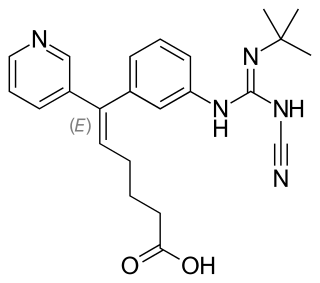
H2 antagonists, sometimes referred to as H2RAs and also called H2 blockers, are a class of medications that block the action of histamine at the histamine H2 receptors of the parietal cells in the stomach. This decreases the production of stomach acid. H2 antagonists can be used in the treatment of dyspepsia, peptic ulcers and gastroesophageal reflux disease. They have been surpassed by proton pump inhibitors (PPIs); the PPI omeprazole was found to be more effective at both healing and alleviating symptoms of ulcers and reflux oesophagitis than the H2 blockers ranitidine and cimetidine.
An international nonproprietary name (INN) is an official generic and nonproprietary name given to a pharmaceutical drug or an active ingredient. INNs are intended to make communication more precise by providing a unique standard name for each active ingredient, to avoid prescribing errors. The INN system has been coordinated by the World Health Organization (WHO) since 1953.

Famotidine, sold under the brand name Pepcid among others, is a histamine H2 receptor antagonist medication that decreases stomach acid production. It is used to treat peptic ulcer disease, gastroesophageal reflux disease, and Zollinger-Ellison syndrome. It is taken by mouth or by injection into a vein. It begins working within an hour.

Cimetidine, sold under the brand name Tagamet among others, is a histamine H2 receptor antagonist that inhibits stomach acid production. It is mainly used in the treatment of heartburn and peptic ulcers.

Ranitidine, sold under the brand name Zantac among others, is a medication used to decrease stomach acid production. It is commonly used in treatment of peptic ulcer disease, gastroesophageal reflux disease, and Zollinger–Ellison syndrome. It can be given by mouth, injection into a muscle, or injection into a vein. In September 2019, the probable carcinogen N-nitrosodimethylamine (NDMA) was discovered in ranitidine products from a number of manufacturers, resulting in recalls.

Antihistamines are drugs which treat allergic rhinitis, common cold, influenza, and other allergies. Typically, people take antihistamines as an inexpensive, generic drug that can be bought without a prescription and provides relief from nasal congestion, sneezing, or hives caused by pollen, dust mites, or animal allergy with few side effects. Antihistamines are usually for short-term treatment. Chronic allergies increase the risk of health problems which antihistamines might not treat, including asthma, sinusitis, and lower respiratory tract infection. Consultation of a medical professional is recommended for those who intend to take antihistamines for longer-term use.

Casopitant (INN), former tentative trade names Rezonic (U.S.) and Zunrisa (Europe), is an NK1 receptor antagonist which was undergoing research for the treatment of chemotherapy-induced nausea and vomiting. It was under development by GlaxoSmithKline. In July 2008, the company filed a marketing authorisation application with the European Medicines Agency. The application was withdrawn and development was discontinued in September 2009 because GlaxoSmithKline decided that further safety assessment was necessary. However, a 2022 review listed casopitant as under development as a potential novel antidepressant for the treatment of major depressive disorder, with a phase 2 clinical trial having been completed.

Vedaclidine (INN, codenamed LY-297,802, NNC 11-1053) is an experimental analgesic drug which acts as a mixed agonist–antagonist at muscarinic acetylcholine receptors, being a potent and selective agonist for the M1 and M4 subtypes, yet an antagonist at the M2, M3 and M5 subtypes. It is orally active and an effective analgesic over 3× the potency of morphine, with side effects such as salivation and tremor only occurring at many times the effective analgesic dose. Human trials showed little potential for development of dependence or abuse, and research is continuing into possible clinical application in the treatment of neuropathic pain and cancer pain relief.

Vestipitant (INN) is a drug developed by GlaxoSmithKline which acts as a selective antagonist for the NK1 receptor. It is under development as a potential antiemetic and anxiolytic drug, and as a treatment for tinnitus and insomnia.

Acefylline (INN), also known as 7-theophyllineacetic acid, is a stimulant drug of the xanthine chemical class. It acts as an adenosine receptor antagonist. It is combined with diphenhydramine in the pharmaceutical preparation etanautine to help offset diphenhydramine induced drowsiness.

Ezlopitant (INN, code name CJ-11,974) is an NK1 receptor antagonist. It has antiemetic and antinociceptive effects. Pfizer was developing ezlopitant for the treatment of irritable bowel syndrome but it appears to have been discontinued.

Terbogrel (INN) is an experimental drug that has been studied for its potential to prevent the vasoconstricting and platelet-aggregating action of thromboxanes. Terbogrel is an orally available thromboxane A2 receptor antagonist and a thromboxane A synthase inhibitor. The drug was developed by Boehringer Ingelheim.

Tums (stylized as TUMS) is an antacid made of sucrose (table sugar) and calcium carbonate (CaCO3) manufactured by Haleon in St. Louis, Missouri, US. They are also available in a sugar-free version. It is an over-the-counter drug, available at many retail stores, including drug stores, grocery stores and mass merchandisers. It provides relief from heartburn and indigestion ("sour stomach").

Epelsiban is an orally bioavailable drug which acts as a selective and potent oxytocin receptor antagonist. It was initially developed by GlaxoSmithKline (GSK) for the treatment of premature ejaculation in men and then as an agent to enhance embryo or blastocyst implantation in women undergoing embryo or blastocyst transfer associated with in vitro fertilization (IVF)., and was also investigated for use in the treatment of adenomyosis.
There are several classes of drugs for acid-related disorders, such as dyspepsia, peptic ulcer disease (PUD), gastroesophageal reflux disease (GORD/GERD), or laryngopharyngeal reflux.

Becampanel (INN) (code name AMP397) is a quinoxalinedione derivative drug which acts as a competitive antagonist of the AMPA receptor (IC50 = 11 nM). It was investigated as an anticonvulsant for the treatment of epilepsy by Novartis, and was also looked at as a potential treatment for neuropathic pain and cerebral ischemia, but never completed clinical trials.

Serlopitant (INN, codenamed VPD-737) is a drug which acts as an NK1 receptor antagonist. It was assessed in clinical trials for the treatment of urinary incontinence and overactive bladder, but while it was superior to placebo it provided no advantage over existing approved drugs, and was not approved for further development for this indication. Serlopitant is now undergoing clinical trials for the treatment of chronic pruritus (itch)
Sufotidine (INN, USAN, codenamed AH25352) is a long-acting competitive H2 receptor antagonist which was under development as an antiulcerant by Glaxo (now GlaxoSmithKline). It was planned to be a follow-up compound to ranitidine (Zantac). When taken in doses of 600 mg twice daily it induced virtually 24-hour gastric anacidity thus closely resembling the antisecretory effect of the proton pump inhibitor omeprazole. Its development was terminated in 1989 from phase III clinical trials based on the appearance of carcinoid tumors in long-term toxicity testing in rodents.

Rolapitant (INN, trade name Varubivə-ROO-bee in the US and Varuby in the European Union) is a drug originally developed by Schering-Plough and licensed for clinical development by Tesaro, which acts as a selective NK1 receptor antagonist (antagonist for the NK1 receptor). It has been approved as a medication for the treatment of chemotherapy-induced nausea and vomiting (CINV) after clinical trials showed it to have similar or improved efficacy and some improvement in safety over existing drugs for this application.

Toripristone (INN) is a synthetic, steroidal antiglucocorticoid as well as antiprogestogen which was never marketed. It is reported as a potent and highly selective antagonist of the glucocorticoid receptor (GR), though it also acts as an antagonist of the progesterone receptor (PR). The pharmacological profile of toripristone is said to be very similar to that of mifepristone, except that toripristone does not bind to orosomucoid. The drug has been used to study the hypothalamic-pituitary-adrenal axis and has been used as a radiotracer for the GR. Its INN was given in 1990.
















